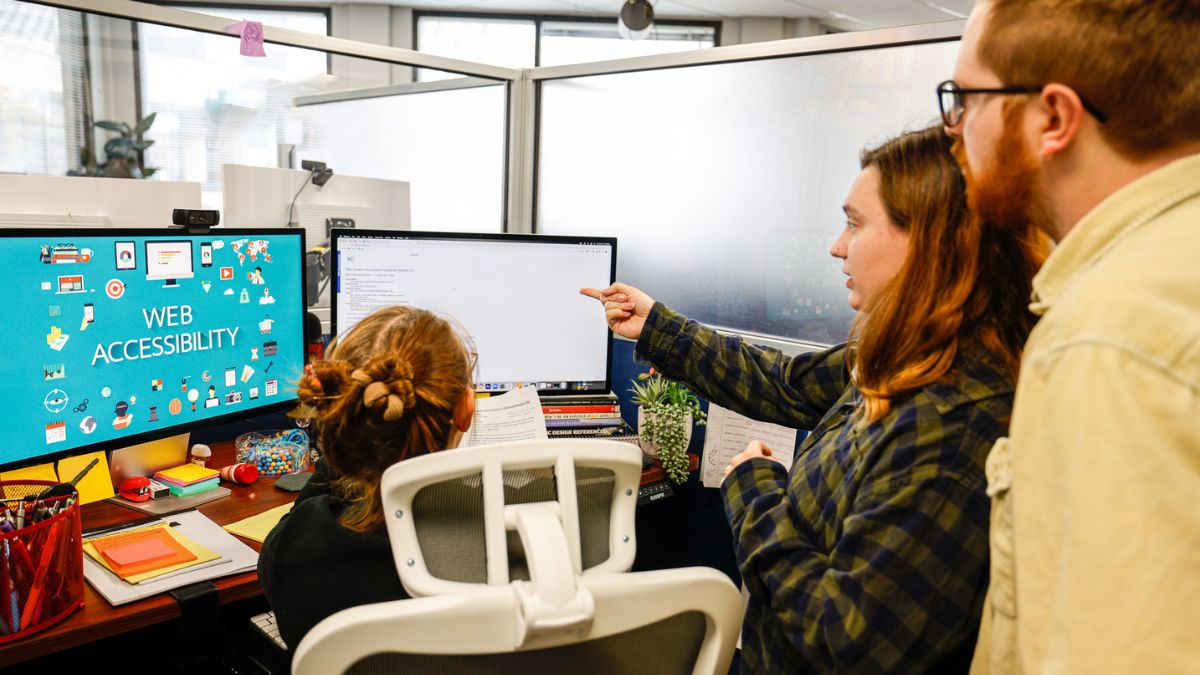
Accessibility in Design – Part 2: 21 Tips for Creating Accessible Content
In July of 1990, President George H.W. Bush signed the Americans with Disabilities Act into law, making it a standard for buildings to be constructed with disabled users in mind. More than 32 years and one pandemic later, it has never been more important that your business is accessible both offline and online. And part of that involves creating accessible content. By focusing on this, you can make your website and other resources more inclusive.
Why is this important?
Based on WHO statistics, about 15% of the global population suffers from a disability, and up to 4% of the population has difficulty functioning due to that disability. Those individuals deserve greater consideration. And the last thing you want to do is alienate from your website or business.
“Accessibility benefits everyone and improves their quality of life.”
In the first part of this series on accessibility in design, we talked about what it is and why it’s important. Now we’ll offer some tips on creating accessible websites and other content for customers with disabilities.
21 Tips for Creating Accessible Content
According to Pew Research, 61% of disabled adults in the US own a laptop or desktop computer. It’s important that website owners and designers think about them when building a functional web design.
We’ve already outlined best practices for a user-friendly web design. Now, let’s look at some practical tips for creating accessible websites based on need.
To Serve Those with Hearing Impairments
Creating accessible content for the hearing impaired is important, especially with the prevalence of video content.
Here are some guidelines to incorporate into your website and other digital content…
- Add Captions to Videos
Make sure all video content contains captions by adding them manually or using speech-to-text technology. Just be careful about using auto-generated captions, as they can be inaccurate.
- Place the caption controls somewhere that is easily accessible to users.
- Don’t hide controls outside the video player or use a separate menu.
- Be sure that captions don’t obscure the video content.
- Ensure Synchronization
Make sure that the audio and captions are well synchronized to facilitate easier processing of content for the hearing impaired.
- Provide Cues
When captioning video content, make sure to provide cues. Identify each speaker as they appear. And remember, there’s no need to add captions for irrelevant audio content (unless they’re present for comedic effect).
To Serve Those with Visual Impairments
Gone are the days when the visually impaired were denied access to a laptop or other computing devices. There are now various options available for those with limited vision, blindness, and color blindness.
Here are some tips for creating accessible content for these individuals…
- Use Colors & Textures for Contrast
Test various contrast ratios on text to ensure readability. You can also use a contrast checker to ensure that you meet your country’s guidelines for accessibility. Add textures when creating graphs and charts for added differentiation.
- Highlight Important Features
Traditionally, web designers use color to highlight important features on a page, such as clickable links. But color can be a barrier for visually impaired users to access the features of your website. You can use still color, but make sure to add another distinguishable element to ensure accessibility.
Here are some options:
- Adjust the font-weight
- Put text in bold
- Underline the text (preferred)
- Use Alt Text on Images
Images are one of the major roadblocks to creating accessible content, especially for visually impaired users. Adding alt text will make it easier for screen reader technologies to describe the images on the web page to the users when they cannot see them. Take the time to edit the alt text instead of just using the image file name.
- Enable Manual Font Size Adjustment
Provide settings on your website pages that allow users to adjust font sizes manually. This tool is helpful for users with low vision, as it eliminates the need for magnifying software.
Further, employ relative sizes instead of absolute units for your text size. This makes it easier to adjust the text size based on the screen size.
- Add Descriptive Labels to Links & Buttons
Use clear descriptions when adding links so that users who rely on keyboard navigation can have context about what each link is for. For people who rely on screen readers primarily, it can get confusing when every button or link reads “Click here to Download,” despite leading to different pages or resources. Which one are they downloading? They won't know unless it has text describing the button.
Adding descriptive labels will also promote the scannability of the page for all users, not just those with visual impairments.
To Serve Those with Motor Impairments
A motor skills disability limits a person’s ability to use their hands or assume a steady posture.
When creating accessible content, consider these limitations and the challenges that might arise in web functionality…
- Make Your Website Usable Via Keyboard

Your website should be usable and easy to navigate with a keyboard. Many individuals with motor skill disabilities, especially those who are unable to use (or have trouble using) a mouse, rely on a keyboard to interact with website features.
- Ensure Clickable Features Are Large Enough
Don’t demand precision from motor-impaired users by limiting the size of links and other clickable features. Some users have difficulty controlling a mouse or keyboard. Make it easy for them to interact with these features even with limited motor capacity.
- Provide Adequate Space
Another factor that would demand precision when navigating a website is when forms and paragraphs are closely bunched together. If you do that, motor-impaired users have a high chance of taking the wrong action by mistake.
So, make sure to provide adequate space between assets on your site pages.
- Eliminate Short Time-Out Windows
Motor-impaired users require plenty of time when interacting with a website feature. Avoid or eliminate short time-out windows that would require them to repeat the action over again if they don’t respond quickly.
- Offer Shortcuts
The fewer clicks and navigation a user must perform, the better. Simplifying the process is a great practice for creating accessible content, especially for those with motor impairments.
To Serve Those with Cognitive Impairments
People with cognitive disabilities can have difficulty reading or comprehending what they read. Make sure you meet the web accessibility standards for creating accessible content for those with this type of disability.
Here are some tips to follow…
- Keep It Simple
Choose a clean page with a simple design. That will enable users to focus on the content rather than getting distracted by unnecessary elements on the page.
- Provide Supplemental Formats
Use other types of content to supplement the text. These other formats will support the ideas presented in text format, especially for users who have difficulty understanding written words or long sentences.
Some examples are as follows:
- Images
- Videos
- Animations
- Aim for Consistency
Maintain a consistent navigation format across all pages on your website. This will enable people with cognitive disabilities to easily identify patterns that make navigation easier.
To Serve Those with Epilepsy
The use of flashing or strobing lights can be a trigger for web users who have epilepsy. Make sure you consider them when creating accessible content or web design.
Apply these tips to your website and other digital assets accordingly…
- Avoid Using Too Many Colors
Make sure you don’t overwhelm epileptic users with too many colors on your website or elsewhere. Stick to your brand’s color palette. Further, strive to use color only when absolutely necessary.
- Think About Contrast
Aside from colors, the contrast can also be a barrier for those with epilepsy using a particular website. Avoid using too much contrast between the text and background color so that the content is easy to read. For example, white text on a black background can be hard to read.
Note: Those with low vision benefit from greater color contrast, so strike a balance that will serve all users.
- Limit the Use of Movement & Animation
Avoid any blinking or flashing elements on your website. If possible, limit the amount of moving content on your web pages or give users the option to turn them off.
Additional Tips for Creating Accessible Content
Here are a few more tips for creating accessible content and websites that can help users across the board…
- Keep Your Website Keyboard-Friendly
This tip was touched on previously, but it’s worth highlighting again.
Your website design should not be dependent on a mouse to function. There are several assistive technologies for disabled users that facilitate keyboard-only navigation for websites. Make good use of these technologies during web design and development so that features on your website, including links and pages, are accessible with a keyboard.
Specifically, users should be able to use the tab button on the keyboard to navigate different web pages.
- Implement HTML Header Tags
Facilitate the easy flow of information within your page by using the correct HTML header tags. This technique makes it easier for users, disabled or not, to easily navigate the information provided on your pages so they are easy to digest and understand.
Takeaway
Is it time to reevaluate your web design for accessibility? Creating accessible content should be a top priority for websites, not just a nice-to-have feature. Taking these extra steps is a great way to showcase you are a leader in your industry and are championing a more accessible world.
“When done right, accessibility in design isn't noticed by those it doesn't affect; however, it means the world to those it does.”
Do you want to build a functional website that’s usable for all? Learn how our full-service marketing agency can help!

